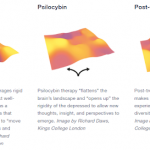
Research conducted by Andrew Adamatzky and published by The Royal Society Publishing indicates that fungi may have hidden languages. According to Adamatzky’s report, mycelial networks, the roots of fungal colonies, create and transport spikes of electrochemical signals similar to those created in the human nervous system during speech.
Adamatzky and his team were able to group the electrical spikes into trains (words), providing them with a basis to build a linguistic model for the fungi. In other words, certain species of fungus are talking to each other. The team then constructed an algorithm and a Liz-Zempel complexity hierarchy to model the fungal sentences.
The algorithm that Adamatzky and his team created showed that fungal word complexity closely resembles that of human speech in both length and pattern. With one species, S. Commune communicates with the highest level of complexity. The team also found complex electrical interactions between mycelium and plant root networks.
One of the most interesting findings, aside from the possibility that the mycelial networks that we all walk across every day are communicating, was how fungal spikes and spike trains resemble human neuron activity. Their findings show that the fungi’s electrochemical spikes vary based on mechanical chemical, optical and electrical stimulation.
Some fungal languages may be more complex than European languages.
During the study, Adamatzky and his team made yet another shocking discovery. They compared the complexity of the fungal spikes (words) to those of certain European languages, primarily English and Russian. They found that some of the fungal counterparts may be more complex. To find this, they converted the speculative mushroom ruminations into binary sequences.
The team then adopted analogies from the English language and made some assumptions about the distance between spikes. They were able to make an interesting finding. In English, an average vowel has a duration of 300 milliseconds (ms), with a minimum and 70 ms and a max of 400 ms. Using this as a baseline, they calculated the spike intervals of the four species (C. Militaris, F. velutipes, S. commune, O. nidi formis). They found that all four species had similar word intervals.
Furthermore, and even more strange, fungi have a relatively complex vocabulary. The researchers found S. Commune, the most linguistically complex of the four species studied, has a lexicon of 50 words. This complexity, combined with an average word length of 5.97 on the Liz-Zempel complexity hierarchy, made them incredibly similar to human speech. For example, the English language had an average score of 4.8, and Russian came in at 6.
What does this mean for human/fungi relations?
For the time being, not much, but it may not hurt to treat your local lawn and garden mushrooms with a little bit of decorum. In all seriousness, while the study is interesting and thought-provoking, it doesn’t mean much on its own. Adamatzky and his team freely admit that the studies of fungal languages via em. spike reading is in its absolute earliest stages, noting that “we don’t even understand the language of cats and dogs.”
The more we learn about the complexities of fungal, plant, and animal languages, the more we will have to think about our relationship with the rest of earth’s plant and animal life. As we discover more about fungal languages, we will inevitably develop a greater understanding of ourselves and our place on Earth. Also, if you happen to be a fan of the Stoned Ape Theory, this new information certainly has some interesting implications.
While mushrooms having language is exciting, there were some limitations.
Adamatzky and his team’s findings are incredible and should make humanity stop for a moment and reconsider what we think of as intelligence and consciousness. However, there are some limitations to the study and its findings.
The team admits that their findings are, for now, just speculative, and the models they used were limited. For instance, using binary is considered a primitive way of classifying and calculating language complexity. Furthermore, the team believes the study needs to be expanded to include more species. Lastly, the team would like to expand the study to look for grammatical complexity, lexicon, and word length.
David Connell is a U.S. Air Force Veteran writer and author of Cooking with Magic: The Psilocybin Cookbook. David holds a B.A. in Communications and Creative Writing from the University of Tennessee, Knoxville. Connect with him about drug policy reform, his thoughts on research in novel psychedelic therapies, creative writing, and his unabashed love for Science Fiction on Twitter, LinkedIn, and Instagram.
Sources
Andrew, A., Andrew Adamatzky Andrew Adamatzky http://orcid.org/0000-0003-1073-2662 Unconventional Computing Laboratory, Adamatzky, A., & Andrew Adamatzky http://orcid.org/0000-0003-1073-2662 Unconventional Computing Laboratory. (2022, April 6). Language of fungi derived from their electrical spiking activity. Royal Society Open Science. Retrieved April 7, 2022, from https://royalsocietypublishing.org/doi/10.1098/rsos.211926
Electrical currents associated with … – Wiley Online Library. (n.d.). Retrieved April 7, 2022, from https://nph.onlinelibrary.wiley.com/doi/10.1111/j.1469-8137.1995.tb04314.x
Fantastic Fungi. (2021, March 25). The Stoned Ape. Fantastic Fungi. Retrieved April 7, 2022, https://fantasticfungi.com/the-mush-room/the-stoned-ape-theory/#:~:text=According%20to%20the%20%E2%80%9CStoned%20Ape,have%20profoundly%20changed%20their%20brains.


No comment yet, add your voice below!